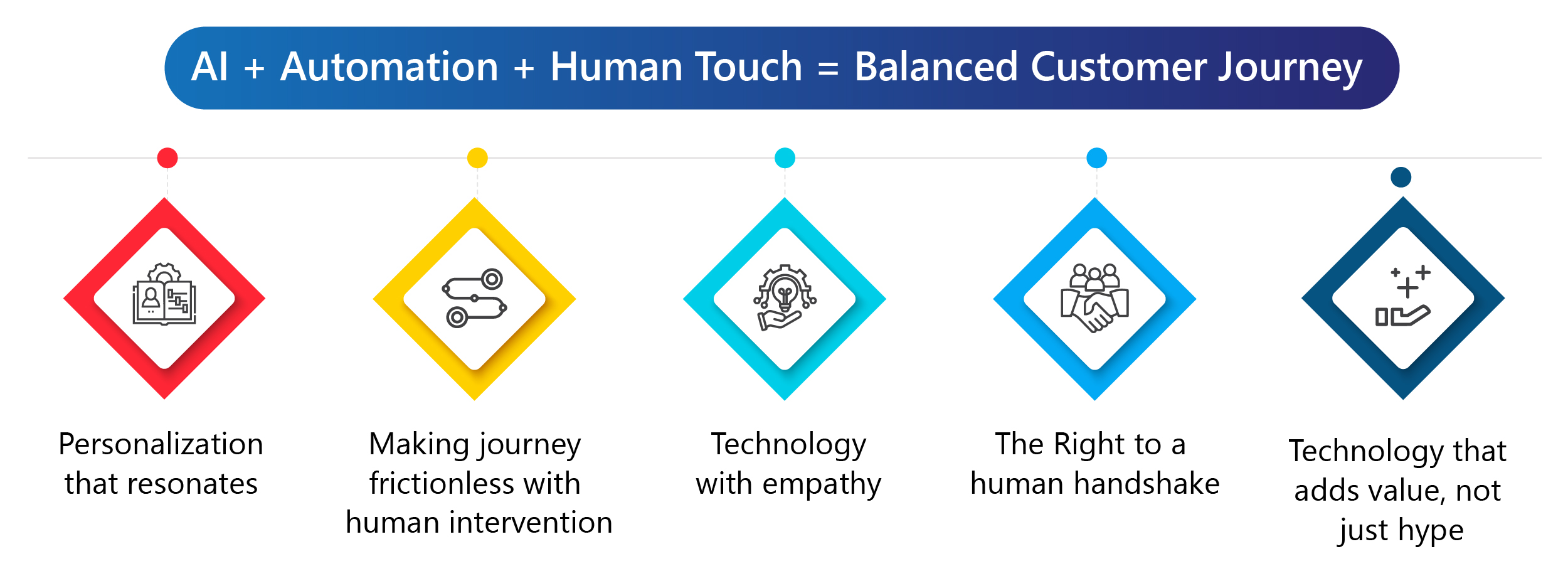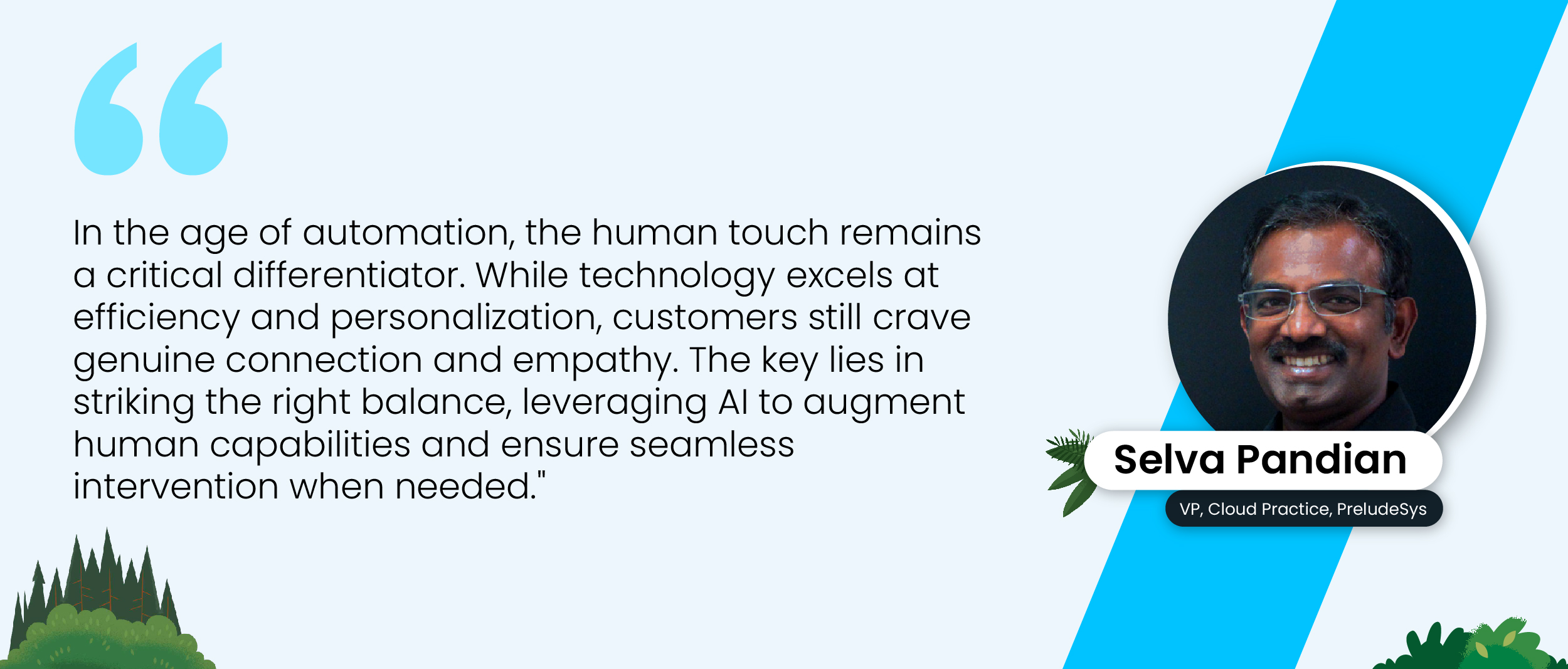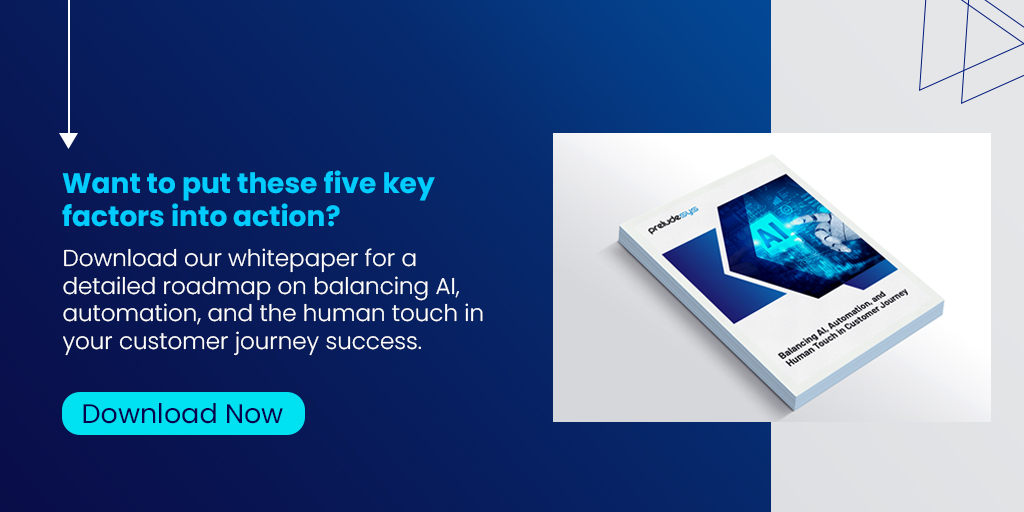Imagine you’re on a long road trip with a reliable GPS to point you in the right direction. However, having a trusted companion can add a human element that makes the trip feel less like a task and more like an adventure.
In today’s high-tech world, AI and automation are like our GPS, providing direction and efficiency. But the human touch is the companion, offering empathy, understanding, and a personal connection. How can we ensure that our customer journeys are not only efficient but also enjoyable and meaningful?
While AI and automation offer undeniable potential for efficiency and personalization, striking the right balance with the human touch remains paramount. Here are five critical factors for achieving this delicate equilibrium.
Five Key Factors for a Balanced Customer Journey
Factor 1: Personalization that Resonates
Personalization imperative: Customers today expect tailored experiences that match their preferences. 80% of consumers are more likely to do business with a company that provides personalized experiences—such as Salesforce. AI analyzes data to personalize content, product recommendations, and marketing messages, which drives customer engagement.
The human touch distinction: Over-personalization can backfire, but the human touch is the key to preventing this. While AI can analyze browsing behavior to personalize email content, a human representative can craft a more natural and engaging tone, making the customer feel genuinely understood. This reassures the customer that algorithms do not solely dictate their experience.
A Real-life Example of Over-Personalized Marketing
Target’s prediction of a teen customer being pregnant and sending relevant product campaigns before the teen’s parents knew about it.
Factor 2: Frictionless Journeys, Powered by Human Insights
AI for streamlining the experience: AI can reduce customer service costs by up to 30%. Customers crave a smooth and effortless journey across all touchpoints. AI can automate repetitive tasks, including scheduling appointments and answering FAQs, and leverage chatbots to answer basic questions. Additionally, AI can predict customer needs based on past behavior, further streamlining the experience. (e.g., suggesting relevant support articles)
Human expertise for course correction: While AI offers efficiency, it’s not infallible. Unforeseen issues or complex problems can arise where human intervention and expertise are critical. Customer service representatives with AI-powered insights can diagnose issues faster and provide personalized solutions, ensuring the journey remains frictionless.
Factor 3: Technology with Empathy
AI for mimicking human nuance: Customers want answers to their queries at any time of the day. According to VentureBeat, over 50% of customers expect a business to be available 24/7. Advances in AI allow it to mimic human communication styles, creating a more natural and engaging experience. Chatbots can be trained to use empathetic language and respond to customer emotions, while AI-powered marketing messages can be crafted with a more human-like tone.
The irreplaceable human connection: Despite AI’s advancements, genuine human connection remains irreplaceable. 91% of consumers value speaking with a live representative when they have questions or concerns (Microsoft, 2022). Customers still appreciate interactions with real people who empathize with their needs, understand their frustrations, and provide emotional support.
Ready to optimize your customer journey? Download our free whitepaper, Balancing AI, Automation, and Human Touch in Customer Journey, to learn how to blend AI and automation with personalized human interaction. Access your free copy of the whitepaper.
Factor 4: The Right to a Human Handshake
Understanding human needs for interaction: While AI and automation offer convenience, some situations demand human interaction. Customers may prefer to speak with a human representative when making complex purchases, dealing with sensitive issues, or simply seeking reassurance. A study by Zendesk (2023) revealed that 67% of customers expect companies to offer multiple channels for customer support (phone, email, and chat).
Strategic human intervention: Companies should identify key touchpoints where human interaction is crucial. For example, they could offer live chat options for complex inquiries or provide dedicated customer success representatives for high-value clients.
Factor 5: Technology that Adds Value, Not Just Hype
Focus on customer needs: Technology should be implemented with a clear purpose—to enhance the customer experience. Simply adopting AI or automation for expediency can be counterproductive, creating unnecessary complexity or frustration for customers.
Human evaluation for actual value: Companies should involve human stakeholders in evaluating the value proposition of new technologies. Customer service representatives and sales teams can offer valuable insights on how technology can best address customer needs and pain points.
Free Customer Journey Checklist: Not sure where to start your customer journey? Our free checklist breaks down the process step-by-step, ensuring a seamless experience from start to finish. Download the checklist now.
Final thoughts
By focusing on these five key factors, high-tech SaaS and software companies can leverage the power of AI and automation to create efficient, personalized journeys while ensuring the human touch remains a cornerstone of exceptional customer experiences. This balanced approach fosters customer loyalty and drives long-term success.
Are you ready to transform your customer experiences with AI and automation? DemanBlue is a subsidiary of PreludeSys that helps you create personalized, efficient journeys that prioritize the human touch. Our expert solutions can help your high-tech SaaS or software company achieve exceptional customer satisfaction and drive long-term success.
🔮Bonus: A free customer journey assessment template is included to help you get started.













